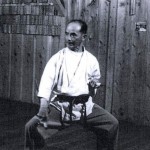 ringing practical applications back into everday karate is a favorite pastime. Various methodology is used to find ever new applications, ranging from trial-and-error, comparative studies, scientific approach, to progressive traditionalism, all with good results.
ringing practical applications back into everday karate is a favorite pastime. Various methodology is used to find ever new applications, ranging from trial-and-error, comparative studies, scientific approach, to progressive traditionalism, all with good results.
In addition, a differentiation between armed and unarmed as well as a combination of these are used. Modern self-defense is included, an example of which can be seen in the Kōdōkan Goshin-jutsu no Kata. The umbrella term used in Japan for such a cumulative extension of an existing martial art to a more integrated (universal) one, while designing and creating new things, is sōgō bujutsu 総合武術, or “integrated martial art”. Maybe it can be seen as the modern-though-orthodox Japanese interpretation of MMA. Naturally, this should be based on thorough practical and theoretical knowledge.
Now I stumbled over an interesting example of a composition that uses various of the above ideas. It is called the “108 Kakie-techniques of the Senbukai”.
The Senbukai
The tradition of the Senbukai goes back to Izumigawa Kanki 泉川寛喜 (1908 – 1969).
During his childhood Kanki studied karate from his grandfather and during high school days he studied the foundations of Gōjū-ryū from Kyoda Jūhatsu 許田重発 (student of Higaonna Kanryō). Following graduation he began studying in earnest from Higa Seiko 比嘉世幸, another student of Higaonna Kanryō. In 1937 he copied the manuscript Bubishi and in 1939 established the Karate-dō Gōjū-ryū Senbukai Sō-honbu in Kawasaki City, Kanagawa Prefecture.
3rd Sōke Izumagawa Katsuya
Currently, Kanki‘s second son Izumagawa Katsuya 泉川勝也 is active as the 3rd Sōke. He is a 9th Dan Hanshi in Gōjū-ryū, a 7th Dan in Sakawa-ha Daitō-ryū, and a Shihan in Ryukyū Kobudō.
From childhood Katsuya Sōke studied the techniques of Koden Gōjū-ryū from his father and 1st Sōke Izumigawa Kanki. Following Kanki’s passing, Katsuya served as the assistant instructor of the 2nd Sōke, his older brother Kanbun 寛文 (1943-82). In 1982 Katsuya inherited the style as the 3rd Sōke.
Katsuya Sōke graduated as an architect from Shibaura Institute of Technology, Department of Architecture and continuously followed the two paths of architecture and karate: On one hand he brought new creativity into architectural design through the combined study of karate and architecture. On the other hand, in karate he studied many years under his father Kanki’s student Yoshimaru Keisetsu 吉丸慶雪 (1931-2014) of the Sakawa-ha Daitō-ryū Aiki-jūjutsu. By incorporating Aiki techniques into Gōjū-ryū he created a unique methodology. Besides, he studied the techniques and Kata of Ryūkyū Kobudō from his uncle Izumigawa Kantoku 泉川寛得.
Currently Katsuya is retired as an architect an spends every day on the research and creation of karate.
108 Kakie-techniques of the Senbukai (泉武会掛け手全108手)
Katsuya enhanced the traditional practice of kakete 掛け手 (kakie カキエ) as handed down in Okinawa Gōjū-ryū with techniques from the Daitō-ryū Aiki-jūjutsu. In this way he newly created the “Senbukai Kakete Zen Hyakuhachi Te” (泉武会掛け手全108手) or 108 Kakie-techniques of the Senbukai. These are close-quarter techniques composed of gyaku, kuzushi, taoshi, hazushi, nage, uchi and other methods.
These 108 techniques can be divided into 4 divisions:
- 48 basic Kakie techniques
- 15 Kaeshi techniques (counters)
- 36 Jissen techniques (actual combat), and
- 9 Ōyō techniques (practical application), also called Ura-waza.
Their compilation and composition was completed in December 2013. So it’s relatively new. See some of the techniques in the videos below:
See kakie starting 6:49′:
© 2015, Andreas Quast. All rights reserved.
